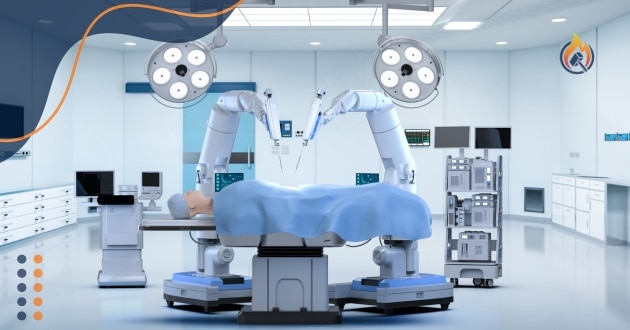The latest advancements in medical technology are, without a doubt, fundamentally transforming healthcare practices across the globe. From state-of-the-art diagnostic tools to ground-breaking treatment methods, these innovations consistently enhance patient outcomes while reshaping the very standards of care. For instance, wearable devices combined with artificial intelligence-powered systems are revolutionizing healthcare by providing real-time monitoring and highly personalized treatment plans. What was once thought impossible has now become a tangible reality, drastically improving lives.
Moreover, it is essential to emphasize that these technologies are not confined to advanced hospitals or urban areas. In fact, the latest advancements in medical technology are explicitly designed to increase accessibility and promote equity in healthcare, ensuring they reach underserved and marginalized communities. This inclusive approach not only bridges healthcare disparities but also guarantees that quality care becomes a universal standard.
Furthermore, it is equally important to recognize that these advancements extend far beyond conventional clinical settings. For example, home healthcare devices and telemedicine platforms are enabling individuals to take control of their health from the comfort of their homes. This evolution is particularly advantageous for residents of rural areas or individuals facing mobility challenges. Clearly, the latest advancements in medical technology are creating a more interconnected, accessible, and inclusive healthcare ecosystem that benefits patients and professionals alike, driving progress in unprecedented ways.
The Role of Artificial Intelligence in Medical Innovation: Latest Advancements In Medical Technology
Artificial intelligence undoubtedly stands out as one of the most transformative latest advancements in medical technology, reshaping the healthcare landscape in countless ways. Continuously evolving, this cutting-edge innovation harnesses advanced algorithms to analyze vast datasets, uncover intricate patterns, and provide highly accurate predictions.
For example, artificial intelligence has brought remarkable improvements to the early detection of severe diseases like cancer. By precisely analyzing medical images, AI has drastically shortened diagnostic timelines, enabling faster interventions. As researcher Emily Carter explains, “Artificial intelligence has significantly reduced diagnostic timelines, enabling quicker interventions and better survival rates.”
Consequently, this groundbreaking technology not only saves lives but also revolutionizes how medical diagnoses are conducted, offering hope and efficiency in equal measure.
Furthermore, the integration of AI-powered chatbot systems is fundamentally redefining patient interactions, enhancing efficiency at every stage of care. These chatbots adeptly respond to patient inquiries, triage symptoms before consultations, and streamline workflows for medical teams.
Institutions such as Mayo Clinic have already adopted these innovative solutions, clearly demonstrating how artificial intelligence improves operational efficiency while substantially cutting costs. In addition, these systems elevate patient satisfaction by reducing waiting times and facilitating better communication.
Moreover, alongside artificial intelligence, other significant advancements in medical technology are also revolutionizing healthcare practices. Devices like wearable health monitors and smartwatches have become indispensable for both patients and professionals. These tools empower individuals to monitor vital health metrics in real-time, enabling proactive management of chronic conditions and promoting a deeper understanding of personal health.
Revolutionizing Healthcare: The Role of Artificial Intelligence in Medical Innovation
These wearables, capable of tracking vital signs like heart rate and oxygen levels, empower individuals to actively manage their health while providing healthcare providers with real-time data for more informed decision-making. Furthermore, the widespread adoption of telemedicine platforms complements these innovations by enabling remote consultations, especially for those in rural or underserved areas. This combination of technologies ensures that healthcare is not only more accessible but also more inclusive and tailored to individual needs.
Equally groundbreaking is the impact of 3D printing in the medical field. This technology has revolutionized the production of prosthetics, implants, and even biological tissues. By enabling highly personalized solutions, 3D printing addresses individual patient needs with unparalleled accuracy. For instance, in developing countries, where traditional prosthetics are often prohibitively expensive, 3D printing offers cost-effective alternatives that maintain high quality.
In summary, the seamless integration of artificial intelligence, wearable technology, telemedicine, and 3D printing underscores the profound impact of modern advancements on the healthcare industry. By leveraging these innovations, healthcare providers can offer faster, more accurate, and more inclusive care. These technologies not only elevate the standards of medical practice but also ensure that patients worldwide benefit from equitable and effective healthcare solutions.
Revolutionizing Healthcare with 3D Printing: Latest Advancements In Medical Technology
A groundbreaking advancement in medical technology is 3D printing, which has revolutionized the production of prosthetics, implants, and even organs. Notably, this technology enables highly personalized solutions that cater to the unique needs of each patient. For example, in developing countries, where traditional prosthetics are often financially or logistically out of reach, 3D printing provides a more accessible and equally effective alternative.
Moreover, bioprinting—a specialized branch of 3D printing—is progressing at an astonishing pace. Researchers are now capable of replicating biological tissues, offering promising solutions for future organ transplants. In fact, experts predict that this technology could soon address the global shortage of organs, saving countless lives and drastically reducing waiting times.
Telemedicine: Reducing Barriers to Medical Access
Telemedicine, meanwhile, has emerged as a vital innovation in the healthcare sector. During the COVID-19 pandemic, this technology became even more essential, allowing patients to consult doctors via video calls and minimizing the need for in-person visits. This not only helped curb the virus’s spread but also ensured continued access to medical care.
Dr. James Edwards, a telemedicine expert, emphasizes, “Telemedicine has drastically improved healthcare access for individuals in remote areas, ensuring timely diagnoses and treatments.”
Robotic-Assisted Surgeries: Precision and Efficiency: Latest Advancements In Medical Technology

Systems like the da Vinci Surgical System provide surgeons with unprecedented levels of precision, flexibility, and control. These features make minimally invasive surgeries more common, resulting in shorter recovery times and fewer complications for patients.
These systems are already widely used in cardiac and orthopedic surgeries. Studies consistently show that patients undergoing robotic-assisted procedures report better outcomes compared to traditional methods.
Wearable Devices: Empowering Patients and Professionals

These devices monitor vital metrics like heart rate, sleep patterns, and activity levels, allowing users to take greater control of their well-being.
Moreover, these devices are increasingly integrated with healthcare systems. Companies like Fitbit and Apple collaborate with medical institutions to use these devices for collecting reliable health data. Wearable devices not only empower patients but also enable healthcare providers to deliver more personalized and effective care.
Case Study: Life-Saving Impacts of Medical Technology
A compelling example of the transformative power of medical technology involves John Smith, a 45-year-old man who faced a potentially life-threatening heart condition. John had always considered himself relatively healthy, dismissing occasional fatigue and shortness of breath as mere signs of aging. However, upon a routine check-up, his physician suggested using a wearable heart monitor to gain deeper insights into his cardiac health. This device, equipped with real-time tracking and advanced diagnostic capabilities, detected irregularities in his heart rhythm that would have otherwise gone unnoticed.
Thanks to this early detection, John’s doctor was able to recommend immediate intervention, including life-saving surgery. Without the integration of such advanced technology into his care, John’s condition might have worsened undetected, potentially leading to a severe cardiac event. The consequences of delayed treatment could have been devastating—not only risking his life but also placing significant emotional and financial stress on his family.
Furthermore, John’s recovery was expedited by continued use of the same wearable technology. This allowed his healthcare team to monitor his progress remotely, ensuring that his heart remained stable while reducing the need for frequent hospital visits. This case not only highlights the critical role of innovative medical devices in preventing catastrophic outcomes but also demonstrates how these advancements enhance recovery and overall quality of life. Ultimately, it underscores the importance of integrating cutting-edge technology into routine healthcare practices for better outcomes.
Conclusion: Embracing the Potential of Medical Technology
The latest advancements in medical technology are far more than mere innovations. They are lifelines that promise a healthier, more efficient, and inclusive future. From artificial intelligence and 3D printing to wearable devices and telemedicine, these technologies are reshaping every aspect of healthcare.
By staying informed and adopting these technologies, both patients and providers can benefit from improved outcomes and greater efficiency. Ultimately, the continued evolution of medical technology ensures that healthcare becomes more accessible, effective, and inclusive for everyone.
In the ever-evolving landscape of Technology News in Canada, innovations are consistently shaping the future of healthcare and beyond. With groundbreaking advancements like artificial intelligence, wearable health devices, and 3D printing, Canada continues to establish itself as a hub for cutting-edge technology that transforms lives. These developments not only redefine medical practices but also enhance accessibility, ensuring that even underserved communities benefit from these breakthroughs.
As highlighted in Technology News in Canada, the nation’s commitment to fostering innovation demonstrates how technology can bridge gaps, improve efficiency, and create a more inclusive and sustainable future. For readers eager to explore how these advancements are shaping everyday life, the intersection of healthcare and technology in Canada is truly a story of progress worth following.


